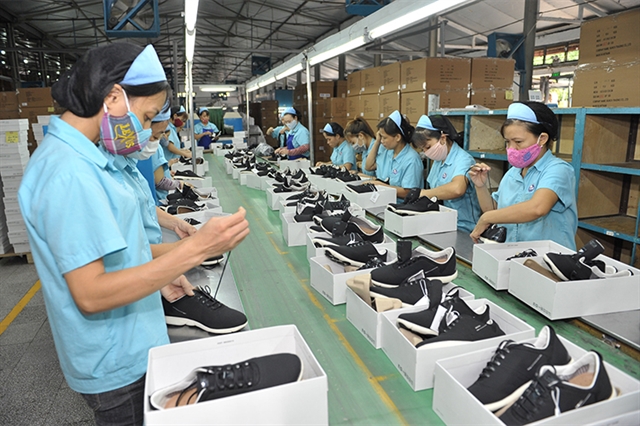 Economy
Economy


|
| Workers on an assembly line at a footwear factory in Đồng Nai Province. — Photo baocongthuong.vn |
HÀ NỘI — Vietnamese exports have recorded many bright spots and impressive numbers after nearly five years of implementing the Comprehensive and Progressive Agreement for Trans-Pacific Partnership (CPTPP).
Export growth at double digits
The Comprehensive and Progressive Agreement for Trans-Pacific Partnership (CPTPP) was officially signed in March 2018 by the remaining 11 member countries of TPP, excluding the US, including Việt Nam, Canada, Mexico, Peru, Chile, New Zealand, Australia, Japan, Singapore, Brunei and Malaysia.
The CPTPP Agreement has been ratified by seven member countries, including Australia, Canada, Japan, Mexico, Singapore, New Zealand, and Việt Nam, and officially took effect on December 30, 2018. CPTPP takes effect in Việt Nam from January 14, 2019.
Evaluating the effectiveness of CPTPP after nearly five years of implementation, Tạ Thu Hà, deputy head of the European - American Market Department under the Ministry of Industry and Trade (MoIT) said that CPTPP has really created a great driving force for Việt Nam's export growth in recent years, while also bringing prestige and great economic efficiency to the country.
The country's export turnover to CPTPP countries continues to grow at double digits. Despite being heavily affected by unfavorable factors such as war and pandemics, Việt Nam's export turnover to CPTPP countries still reached US$53.6 billion last year, a year-on-year increase of 17.3 per cent.
Particularly for markets where Việt Nam has FTA relations for the first time in CPTPP such as Canada, Mexico, and Peru, growth has always been at a continuously high level over the years, increasing between 12 and 30 per cent.
In addition, there is a significant trade surplus with these countries. The total trade surplus from Canada, Mexico, and Peru has reached $11 billion last year, accounting for 95 per cent of Việt Nam's total trade surplus with the world last year.
In addition, the high tariff reduction helps increase the competitiveness and market access of Vietnamese export goods to the world and countries in the CPTPP region.
The Doanh Nghiệp Việt Nam (Vietnamese Enterprises) Magazine quoted Hà as saying that this agreement had also brought indirect benefits in terms of reputation and prestige of an open, dynamic economy.
In recent years, especially since Việt Nam became a member of CPTPP, we have noticed that more and more businesses, organisations, and government agencies in Mexico and Canada have come to us to ask for information to support co-operation with Việt Nam, said Hà.
Benefits and bright spots
Assessing the benefits gained from CPTPP for the Asia-Africa market, Nguyễn Tuấn Dũng from the MoIT’s Asia - Africa Market Department said that this agreement has brought four benefits.
Firstly, similar to the European -American region, CPTPP has helped trade between Việt Nam and countries in the region grow significantly.
Import-export turnover between Việt Nam and six member countries of CPTPP in Asia reached $89.2 billion last year, a year-on-year growth of 8.6 per cent.
Especially, exports rose by up to 20 per cent, in which import-export turnover grew the most in Brunei with an increase of up to 147 per cent.
Secondly, CPTPP is really a lever to promote Vietnamese goods to other countries. In particular, some demanding markets such as Japan, Australia and New Zealand have also recorded the immediate elimination of import taxes on many important traditional export items of Việt Nam such as wooden products, and agricultural and aquatic products.
This has directly boosted the scale of Việt Nam's trade with partner countries in the CPTPP, as well as promoting its economic growth, noted Dũng.
Thirdly, through CPTPP, Việt Nam has the opportunity to take advantage of input sources with competitive prices and a very competitive source of imported raw materials.
From there, Việt Nam could enhance production and boost the export of goods to other member countries with which Việt Nam did not have FTAs such as Canada, Mexico or Peru, he added.
At the same time, it was also possible to take advantage of CPTPP to promote exports to countries and regions that were intending to become members of CPTPP such as China or Taiwan, he said.
Fourthly, CPTPP would create opportunities for Vietnamese businesses, especially in improving their competitiveness in the international market, he added.
At the same time, it was a driving force to increase the technological content of Vietnamese exports, contributing to promote Vietnamese goods to large and demanding markets, he said.
From the perspective of industry associations, Phan Thị Thanh Xuân, General Secretary of the Leather, Footwear and Handbag Association (Lefaso), assessed that CPTPP was one of the very important agreements for the leather and footwear industry.
When the agreement was implemented, export growth to this market was very rapid at over 20 per cent.
Notably, thanks to the implementation of this agreement, the shift of the supply chain of raw materials and accessories has entered Việt Nam, contributing to the growth of the localisation rate of products.
Previously, the localisation rate was only about 45 per cent, but now it has risen to 55 per cent, said Xuân.
It could be said that this was one of the significant successes for the leather and footwear industry besides export growth, she emphasised. — VNS




